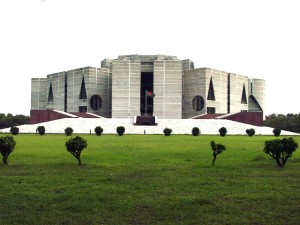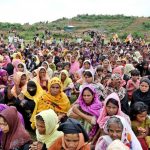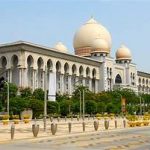Jatiyo Sangsad Bhaban is the National Assembly Building of Bangladesh, located in Sher-e-Bangla Nagar of Dhaka. It was created by architect Louis I. Kahn and is one of the largest legislative complexes in the world for all parliamentary activities of Bangladesh.
Architecture and design
and design
Louis Kahn designed the entire Jatiyo Sangsad complex, which includes lawns, lake and residences for the Members of the Parliament (MPs).
Location and basic layout
The main building is divided into three parts:
1. The Main Plaza: 823,000 square feet (76,000 m²)
2. South Plaza: 223,000 square feet (21,000 m²)
3. Presidential Plaza: 65,000 square feet (6,000 m²)
The main building is at the center of the complex. The outer parts of the complex include the MP hostel. An intricately designed lake surrounds the main building.
Design philosophy
Kahn’s key design philosophy optimizes the use of space while representing Bangladeshi heritage and culture. External lines are deeply recessed by porticoes with huge openings of regular geometric shapes on their exterior, shaping the building’s overall visual impact.
In the architect Louis Kahn’s own words:
“In the assembly I have introduced a light-giving element to the interior of the plan. If you see a series of columns you can say that the choice of columns is a choice in light. The columns as solids frame the spaces of light. Now think of it just in reverse and think that the columns are hollow and much bigger and that their walls can themselves give light, then the voids are rooms, and the column is the maker of light and can take on complex shapes and be the supporter of spaces and give light to spaces.
I am working to develop the element to such an extent that it becomes a poetic entity which has its own beauty outside of its place in the composition. In this way it becomes analogous to the solid column I mentioned above as a giver of light.
It was not belief, not design, not pattern, but the essence from which an institution could emerge…”
Source: Louis I. Kahn. from Heinz Ronner, with Sharad Jhaveri and Alessandro Vasella Louis I. Kahn: Complete Works 1935-74. p236, 238.
The lake on three sides of the Bhaban, extending up to the Members’ hostel adds to site’s aesthetics and also portrays the riverine beauty of Bangladesh.
The assembly building received the Aga Khan Award for Architecture in 1989.
The Bhaban style
The Bhaban consists of 9 individual blocks: the eight peripheral blocks rise to a height of 110′ whereas the central octangular block rises to a height of 155′. All 9 blocks embrace totally different|completely different} teams of purposeful areas and have different levels, inter-linked horizontally and vertically by corridors, lifts, stairs, light-weight courts, and circular areas. the whole structure is intended to mix into one single, non-differentiable unit, that seems from the outside to be one story.
The main committee rooms area unit settled at level 2 in one in every of the peripheral blocks. All parliamentary functionaries, as well as Ministers and chairpersons of a number of the Standing Committees, have offices within the Bhaban. The Parliament Secretariat conjointly occupies offices within the same building.
The Main Plaza
The most necessary a part of the most Plaza is that the Parliament Chamber, which might house up to 354 members throughout sessions. There are 2 podiums and 2 galleries for personage guests. The Chamber includes a most height of 117′ with a parabolic shell roof. The roof was designed with a clearance of one story to let in daylight. Daylight, reflective from the encircling walls and octangular drum, filters into the Parliament Chamber. The economical and aesthetic use of sunshine was a powerful field of study capability of gladiator designer.
The artificial lighting system has been rigorously devised to produce zero obstruction to the entry of daylight. A composite lighting fixture is suspended from parabolic shell roof. This lighting fixture successively consists of a metallike internet, spanning the whole chamber, that supports the individual lighting fixtures.
Upper levels of the block (that contains the Chamber) contain the traveller and press galleries, still as communication booths, all of that overlook the Parliament Chamber. The block conjointly contains: level one, a library; level 3, MPs’ lounges; and the higher level, party rooms.
The South Plaza
The South Plaza faces the Manik Mia Avenue. It bit by bit rises to a 20′ height and is a gorgeous exterior still because the main entrance (used by members throughout sessions) to the Parliament Building. It contains: dominant gates, a driveway, a main mechanical plant space, an outsized automotive parking zone, a work, offices of maintenance engineers, instrumentality stores associated an open plaza with steps and ramps leading on to the most building.
Presidential Plaza
The Presidential Plaza lies to the North and faces the Lake Road. It functions as associate intimate plaza for the MPs and alternative dignitaries. It contains marble steps, a gallery associated an open pavement.





